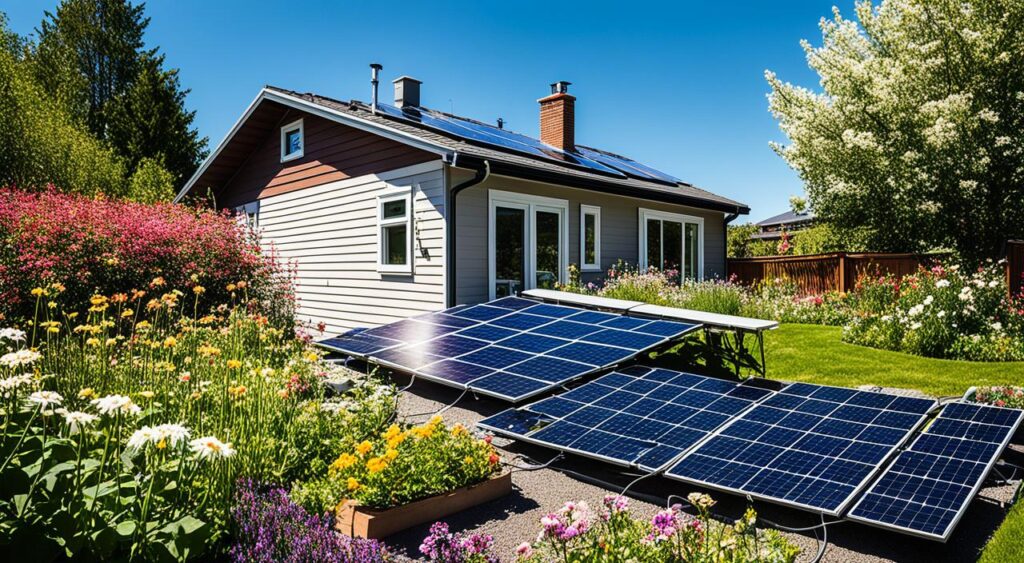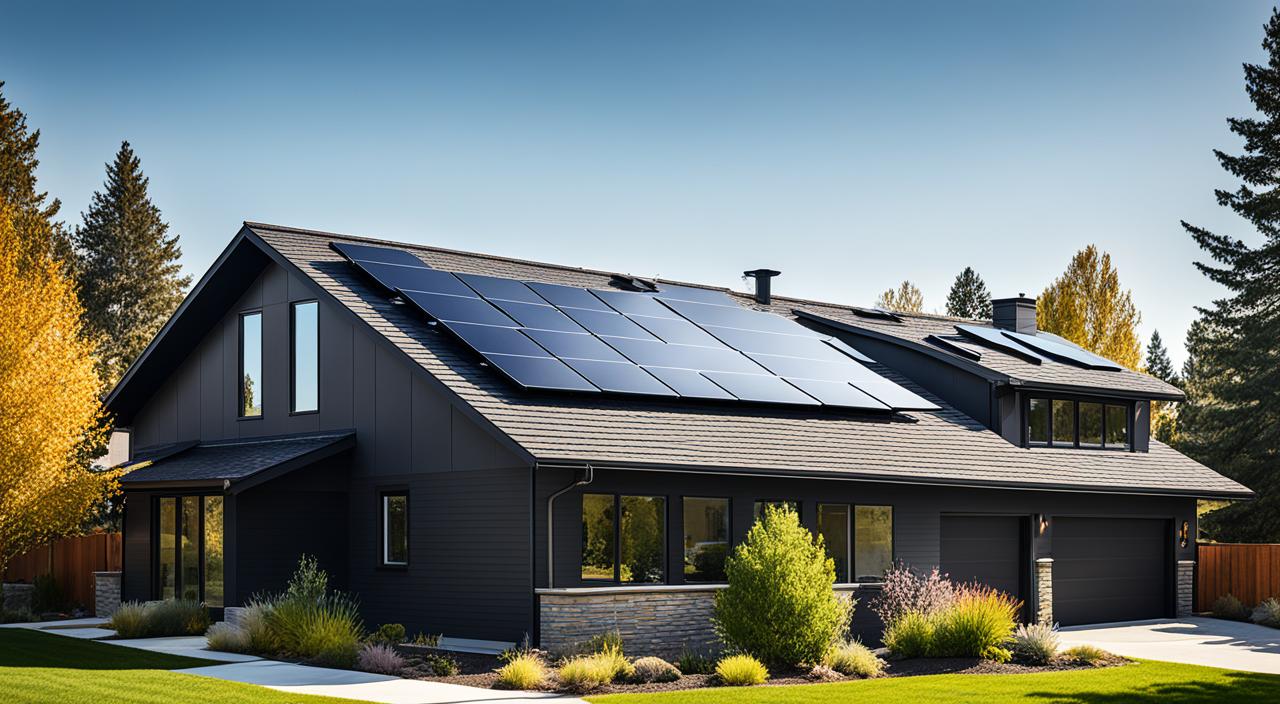Beginner’s Guide to Home Solar Panels
More and more homeowners in the U.S. are turning to renewable energy. Solar power is a top choice because it’s easy to get and use. This guide will cover the basics of solar energy for homes. We’ll look at the different solar panel systems and how to plan and install one at your place.
Key Takeaways
- Solar energy is a renewable and clean source of power for homes, reducing reliance on traditional fossil fuels.
- Residential solar panel systems can provide significant energy savings and increase the value of your home.
- Understanding the types of solar panel systems and assessing your home’s solar potential is crucial for a successful installation.
- The solar panel installation process involves obtaining permits, choosing the right system, and connecting your home to the grid.
- Maintaining your solar panel system through routine tasks can ensure optimal performance and longevity.
Understanding Solar Energy for Homes
Solar energy is a green and lasting way to make power. It uses photovoltaic technology to turn sunlight into electricity. This makes it a top choice for homeowners wanting to cut energy costs and lessen their environmental impact.
What is Solar Power?
Solar power turns sunlight into electricity. Photovoltaic cells in solar panels catch sunlight and make direct current (DC) electricity. This DC electricity is then changed into alternating current (AC) electricity. This AC electricity powers homes and businesses.
Benefits of Going Solar
Going solar has many perks for homeowners. A big plus is saving on energy costs. By making their own renewable energy, homeowners use less traditional energy and pay less on their bills. Solar panels also boost a home’s value, making it a smart investment.
But there’s more to it than just saving money. Solar energy is good for the planet too. It cuts down on fossil fuel use, which means less greenhouse gases and less climate change. This makes solar power great for homeowners who care about the environment.

“Solar energy is the future of renewable power, and homeowners who embrace it are not only saving money but also playing a vital role in creating a more sustainable future.”
Types of Residential Solar Panel Systems
Homeowners have many options for solar energy systems. Knowing the different types helps you pick the best for your home and energy use. Let’s look at the three main types of systems:
Grid-Tied Solar Systems
Grid-tied solar systems are the most common for homes. They connect to the power grid and let homeowners make their own solar power. They also use the grid for power when needed.
These systems often have net metering. This means homeowners can sell extra solar energy back to the power company.
Off-Grid Solar Systems
Off-grid solar systems work on their own, not needing the power grid. They’re great for places far from the grid or where it’s hard to get power. These systems store solar energy in batteries, giving homes their own power source.
Hybrid Solar Systems
Hybrid solar systems mix grid-tied and off-grid tech. They connect to the grid but also have battery backup. This is good for power outages or when your home uses more energy than the solar panels make.
Choosing a solar system depends on your energy needs, budget, and local rules. Talking to a trusted solar installer can help you decide and make sure the setup goes smoothly.

Beginner’s Guide to Home Solar Panels
Assessing Your Home’s Solar Potential
Before you start with solar panels, check how well your home can use solar energy. Look at several important factors to find the best spot and size for your panels. This ensures they work well and make lots of energy.
First, think about your roof’s direction. It should face south or southwest to get the most sunlight. The roof’s slope is also key, with a 15 to 40 degree angle being best for solar panels.
Then, look at any shadows on your roof. Trees, buildings, or other things can block sunlight and lower your panels’ performance. Use tools or get expert advice to spot any shaded spots on your roof.
Lastly, think about how much sunlight your area gets. This varies by location and weather. Check historical data or talk to a solar expert to see how much sunlight your place gets.
By looking at these things, you can make sure your solar system works great. It will produce more renewable energy and save you money.
Planning Your Solar Panel Installation
Starting with solar power for your home requires careful planning. Choosing the right solar panel system and getting the right permits are key steps. They make sure your installation goes smoothly and successfully.
Choosing the Right Solar Panel System
When picking a solar panel system, think about efficiency, output, and cost. These factors help you find a good balance between how well it works and what it costs. Talking to a trusted solar installation company can also give you great advice and help.
Obtaining Permits and Approvals
Getting the right permits and approvals is a must before installing solar panels. It makes sure your system is safe and follows the rules. Know what your area requires and work with your installer to get everything approved without trouble.
| Consideration | Explanation |
|---|---|
| Panel Efficiency | Higher-efficiency panels can generate more power from the same roof space, but they may be more expensive. |
| Panel Output | Evaluate the power output of different panel options to ensure your system meets your energy needs. |
| Panel Cost | Balance the upfront cost of the panels with their long-term energy savings and return on investment. |
Planning your solar panel installation well puts you on the path to using the sun’s power. Look into solar rebates and incentives to make your investment in renewable energy sources and energy savings even better.
Solar Panel Installation Process
Starting to use solar power for your home is a big step towards a greener future. The process of putting in solar panels is detailed and needs experts. We’ll walk you through the main steps, from checking out your site to connecting to the power grid.
The first step is a detailed check of your home. Experts look at your roof, how it faces the sun, and how much sun it gets. They pick the best spot and setup for your solar panels. This makes sure your system works well and saves energy.
- Permit Acquisition: Next, you need to get the right permits and approvals. This makes sure your solar setup is safe and follows the rules.
- System Design and Engineering: After checking your site, the team designs a system just for your home. They choose the right panels, inverters, and parts to make the most energy and save money.
- Equipment Procurement and Delivery: Once the design is set, the company buys all the needed parts and materials. They make sure everything meets the standards and is safe.
- Installation and Interconnection: Then, skilled technicians put in the solar panels and other parts. They connect it to your home’s power and link it to the grid.
It’s important to work with a trusted and skilled solar company during the installation. They know all about permits, rules, and safety. This ensures your solar setup is done right, giving you the best benefits from solar panel installation, renewable energy sources, and energy savings.
| Step | Description |
|---|---|
| Site Evaluation | Check your home’s roof, direction, and sunlight to find the best spot for panels. |
| Permit Acquisition | Get the needed permits and approvals to make sure the setup is safe and follows the rules. |
| System Design and Engineering | Make a solar system just for your home, picking the right parts for the best energy and savings. |
| Equipment Procurement and Delivery | Buy the solar panels, inverters, and other parts needed, making sure they’re up to standard. |
| Installation and Interconnection | Put in the solar panels and connect them to your home’s power, linking to the grid. |
“Putting in solar panels is a big step towards a greener future. With experts, homeowners can get a safe, efficient, and right setup. This boosts their investment in solar panel installation, renewable energy sources, and energy savings.”
Connecting Your Solar System to the Grid
After setting up your solar panels at home, connecting them to the electrical grid is the next big step. This process, known as grid-tied solar, helps you save more energy and get the most out of your investment.
Understanding Net Metering
Net metering is the core of grid-tied solar systems. It lets homeowners with solar panels get credits for the extra electricity they produce and send back to the grid. When your panels make more energy than you use, the extra power goes to the grid, and you get a credit on your bill.
This is great during the sunny peak hours when your panels work best. It helps you use less energy and might even give you credits from the utility company. Knowing about net metering is key for homeowners wanting to save more money and get the most from their solar system.
To connect your solar system to the grid, you’ll need to work with your local utility company. They’ll check your system for safety and technical standards. This includes getting permits, passing inspections, and signing an agreement. By doing this, you can easily link your solar panels to the grid and enjoy the benefits of your renewable energy.
Grid-tied solar systems have many benefits. They help lower your energy bills, give you credits through net metering, and support a greener energy future. As you move towards energy self-sufficiency, learning how to connect your solar system is an important part of the process.
Maintaining Your Solar Panel System
Keeping your solar panel system in top shape is key to getting the most out of renewable energy. Regular upkeep is vital for your system to work well and save you money on energy.
Routine Maintenance Tasks
Here are some important steps to keep your solar panels running smoothly:
- Panel Cleaning: Clean your solar panels often to remove dirt and debris. Use a soft brush and mild detergent to gently clean them.
- Electrical Component Inspection: Check the electrical parts, like connections and inverters, to make sure they’re working right. Look for any damage and fix it quickly.
- Output Monitoring: Watch how much energy your panels produce. Compare it to past data or what you expect. If the energy output changes a lot, there might be a problem.
- Shading Assessment: Check your panels for new shadows from trees or buildings. Trim back any plants or adjust things to get more sun.
- System Inspection: Look over your whole solar system, including the mounts and inverters, for any issues or ways to improve it.
By doing these maintenance tasks regularly, you’ll keep your solar panels working well. This means you’ll save more energy and help the environment by using less fossil fuels.
| Maintenance Task | Frequency | Benefits |
|---|---|---|
| Panel Cleaning | Every 6-12 months | Improved energy production, increased system efficiency |
| Electrical Component Inspection | Annually | Identification of potential issues, prevention of system failures |
| Output Monitoring | Continuous | Early detection of performance changes, optimization of energy savings |
| Shading Assessment | Bi-annually | Maximization of solar panel efficiency, increased energy generation |
| System Inspection | Annually | Identification of maintenance needs, extended system lifespan |
Solar Rebates and Incentives
Installing a home solar panel system comes with big benefits, like rebates and incentives from the government. These can help lower the cost of going solar. This makes using renewable energy easier and cheaper for homeowners.
The Solar Investment Tax Credit (ITC) gives you up to 26% off the total cost of your solar system. You can claim this on your taxes, saving a lot of money. Plus, many states have their own solar programs. These include net metering, which lets you sell extra electricity back to the grid.
Solar Renewable Energy Certificates (SRECs) are great for homeowners with solar panels. They represent the green benefits of your solar energy. You can sell these certificates to companies, earning more money from your solar panels. By using these rebates and incentives, we can make renewable energy more affordable for everyone in the U.S.

